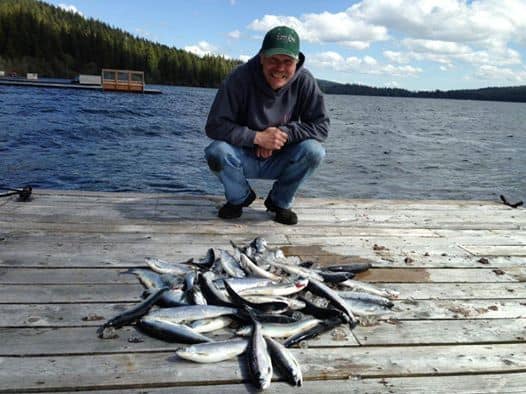Kokanee are landlocked salmon that come in a small package: Anglers who fish for them do so because they are fierce fighters and delicious fish.
Kokanee have converted many a trout angler. They will give you a great fight on light tackle and can be plentiful in deep, cold lakes and reservoirs.
Kokanee are a landlocked form of sockeye salmon that occur naturally in certain lakes in the Pacific Northwest and Alaska and even across the Pacific Ocean to Russia, Japan and Korea.
These freshwater pan-sized salmon also are called silvers, silver trout or often simply “kokes” by those who catch them.
The popularity of kokanee fishing has been growing significantly in recent decades, particularly as state wildlife agencies have been planting them in lakes and reservoirs far beyond their natural range.
These frequently larger-sized lakes are where they can thrive and provide great fishing and guilt-free eating in an era when many of the ocean-going salmon runs are in decline.
Though nearly always smaller than their anadromous brethren, kokanee still taste great and provide the excellent fight for which sockeye are revered.
Kokanee are bright silvery fish with a dark blue back for most of their life cycles.
As the spawning season approaches, they turn from silver to orange to deep red, and the male develops the characteristic hook-jaw and green head common to the sockeye salmon.
A deeply forked tail also sets them apart from trout that often share the same waters.
Kokanee: When and Where
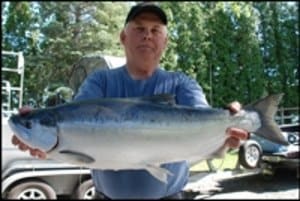
Stocking has been widespread in parts of the U.S. that have large, deep and cold lakes and reservoirs.
You can target kokanee in many states from California to Maine. They are prominently represented throughout the mountain west and are incredibly popular trolling targets wherever they are found.
Fisheries management throughout the country use kokanee to help revive local waters.
Not only are kokanee excellent game fish in their own right, game fish including large trout feed on smaller kokanee, which in turn leads to trophy trout fishing. Some of the biggest brown and lake trout are found where they can feast on kokanee.
Managing kokanee populations with the help of those big predatory fish can also help maintain a kokanee fishery with fewer but larger and more desirable fish.
Finding kokanee can take time and patience, especially as you learn how, when and where to target them.
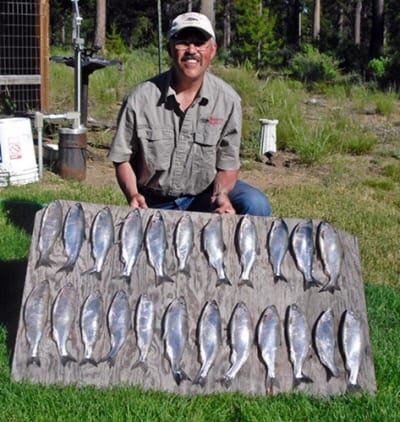
Kokanee like colder water than many trout. The ideal water temperatures they prefer range from 45 to 55 degrees Fahrenheit.
This is why kokanee thrive in colder lakes and often seek out deep water during the hotter months, as they try to escape water that is above about 60 degrees.
Early season will have kokes holding near the surface, then moving into deeper water as the temperatures climb.
Also, in most lakes kokanee primarily eat plankton, which is light sensitive, so on sunny days, they will go deeper still to forage. They may also eat small insects, freshwater crustaceans and sometimes other small fish.
Kokanee move around the lake constantly, often in large schools.
Just because you found them there yesterday doesn’t mean they will be in the same spot today.
Fish finders will help tip the odds in your direction a little.
Since kokanee are a schooling fish, they are pretty easy to mark on the finder.
I’ve fished in lakes like Oregon’s Odell Lake where the kokanee can school so thickly that the fish finder gets confused and marks the school as a false bottom far above real lake’s actual depth.
If you are hunting for kokanee and don’t see other boats with their nets out to indicate the presence of biting fish, target your search to areas with a little current, wind-blown points, and large points that jut out into the lake.
Plankton tends to get pushed up by currents and wind, so follow along to find the kokanee.
How to Catch Kokanee
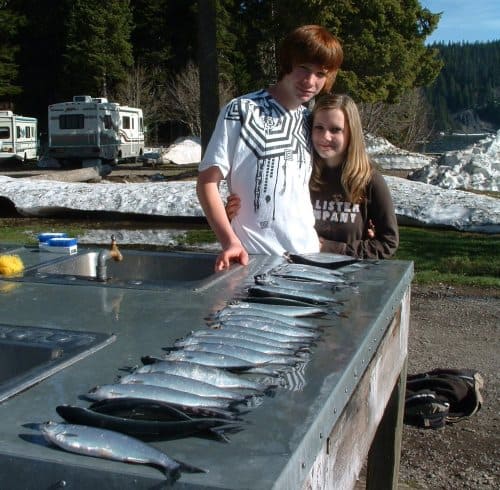
Finding kokanee is usually the first order of business, but once you are on a school, what do you do?
Let’s break down some techniques to help you bring more kokes to your net.
First and foremost, get the right equipment.
Kokanee are frenetic little fighters.
A medium-light action rod around 6 to 7 feet will give you the backbone needed to bring a kokanee to your net while still getting the most out of the fight.
Light or ultra-light tackle can be used when trolling or jigging, which will ensure you get the most out of the experience.
Some manufacturers make a very soft-tipped rod that helps provide some shock absorption, because kokanee have notoriously soft mouths and the force of the strike on a moving lure can tear the hook out quickly.
Trolling for Kokanee
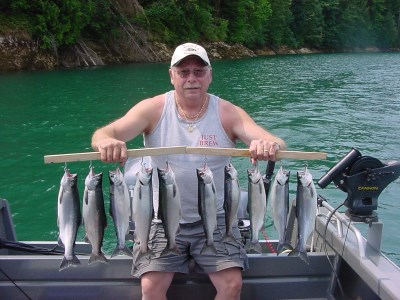
Trolling is easily the most productive and commonplace method to target kokanee.
Most frequently kokanee anglers will arrive at the lake with downriggers and a fish finder, to both find and target kokanee at the right depth.
If you don’t have downriggers, you’ll often need to use weight to reach the schools. Kokanee won’t come very far up in the water column to strike a lure. You must deliver it to them.
And if you don’t have a fish finder, watch where other boats are fishing, especially those who are netting fish, and circle around the same areas, within a polite distance of course.
Kokanee often require slower trolling speeds than you may be used to. Keep it slow, ranging from .6 mph to 1.8 mph. Some anglers may be accustomed to trolling faster for trout.
Since kokanee can move about through the water column, using downriggers will allow you to change the trolling depth pretty easily, keeping the bait in front of the fish.
Trolling without downriggers can be done by setting up inline weights to carry your bait down deep enough, but know the amount of line let out and the speed of the boat to allow you to duplicate results.
Try fishing multiple rods (as many as are legal for your party and license) at different depths until you start catching fish and can focus in on that depth. You can count “pulls” from the reel to help gauge depth.
Sometimes kokanee will follow your gear around the lake without striking, watching and waiting until something changes.
They may strike when they think your bait is getting away or they get irritated.
A great tip is to vary your trolling presentation.
Taking S turns while have the effect of slowing and speeding your lures. Or bringing your downrigger up one and dropping back down may also get them to strike.
Kokanee Trolling Lures
Lures and tackle used for kokanee aren’t so much imitating baitfish as much as they are irritants.
Kokanee don’t like to be messed with, and as long as the lures don’t mimic predatory fish, they will aggressively attack.
Predatory patterns will scare an entire school, shutting down the bite while they search for safer forage waters. Remember that most other gamefish in the water want to eat them, so they are a bit skittish.
Most kokanee lures fall into one of two categories. Those with side-to-side action and those that run straight through the water.
Lures with their own action need to be set up at least three to four times the length of the dodger or flashers above it. That will keep the natural movement of the lure working properly.
Lures with no action can be connected much closer to the dodger, allowing the dodger to transfer movement into the lure.
Needlefish and Kastmaster spoons, Wedding Ring and Panther Martin spinners, and squid hoochies are just a handful of examples among a much longer list of trolling lures that catch plenty of kokanee. There are likely lake favorites wherever you fish.
Kokanee love bright colors like hot pink, fluorescent reds and oranges, and chartreuse. Glow and UV colors are great for deeper water conditions.
We recommend you bring a variety of lures in different colors, because the hot ticket one trip might be a dud the next.
Rubber Snubbers for Kokanee
As mentioned with the discussion of rods, kokanee have famously soft mouths and tend to throw hooks.
Especially when trolling, which adds impact to the strike on a lure, kokanee will sometimes tear off the hook before you even get the fight started.
Many kokanee anglers will help reduce this problem by adding a small rubber snubber to the other end of the leader.
The snubber provides a quick stretch that works as a shock absorber, which many kokanee trollers believe increases the odds of landing these fish.
Dodgers, Flashers, and other Kokanee Attractors
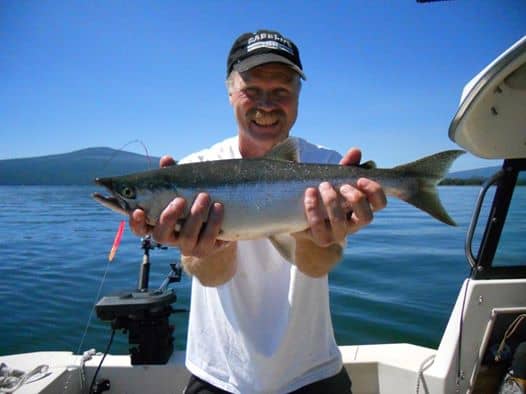
Dodgers and flashers in a variety of styles all have the same aim: They are attention grabbers, which help bring kokanee closer so the lure can do its part and close the deal.
Dodgers are larger and impart more action to the lure, while flashers or lake trolls are a set of blades that spread out the flash. Both may resemble the flashing of a feeding school of kokanee that gets the real kokanee to investigate.
Be cautious with the size of your attractors, especially big dodgers. Larger sizes often deployed for bigger salmon or trout can replicate predator fish, scaring the school off the bite.
In clear water, stick to the 4-inch range, and upping that to 6-inch dodgers in murky or cloudy water.
Some flashers and dodgers can be tuned by gently bending to add or restrict action.
Kokanee Baits and Scents for Trolling
Scent can make the difference between catching a couple and catching your limit.
Putting bait on your lure can also increase your chances, though make sure not to put too much on. Overloading the lure will inhibit the action.
For bait, use some pink maggots, dyed-cured or sweet canned corn, or dyed-cured shrimp. One or two little maggots or kernels should do.
Salmon can smell incredibly well, so using bait and a bit of scent will get their attention.
Using an added scent attractant is also a great idea to cover your own scent as well.
Fish aren’t naturally attracted to most of the scents we as humans enjoy.
Whether it’s sunscreen, gasoline or cigars, it all leaves a scent behind that doesn’t attract fish.
When you think of scents, you probably first consider scents that that naturally attract kokanee, such as shrimp/krill super gel.
However, there also are scents that are irritating to kokes. Anise and garlic are good options to try out if the fish aren’t cooperating, as they may strike out of irritation.
Jigging for Kokanee
Bright metal jigs can be fantastic if you pinpoint a school of kokanee. Jigging a lure around the fish can produce fast action. In some places, where the kokanee are so plentiful there’s a big bonus bag limit, jigging is often the best way to put them into the boat quickly.
Rigging a kokanee jigging setup is pretty simple. Let’s dig into what you’ll need to get started. You’ve probably got most, if not all, in your supplies already.
A good rod to use is 6 to 7 feet in length that can handle weights up to an ounce.
Make sure the rod is sensitive at the tip but has enough backbone for a solid hook set and spirited fight.
In some lakes, the kokanee jigs will occasionally tempt larger Mackinaw or other predators, so be prepared for an especially big fight if that happens.
With kokanee, typically the more sensitive the rod tip, the better.
It’s common to have very light bites that most anglers miss. With a sensitive rod, you’ll be able to pick up on those bites easier, giving you a much higher chance of success.
A common reel to use is the level wind reel with a counter. Being able to accurately count how deep your jig is will help immensely.
You can go with a standard spinning reel, though counting out the right depth can be a bit tedious as you pull a foot of line at a time.
Spool up with 8-pound main line.
Braid doesn’t have any stretch to it, so it’s great for helping with a quick hookset. On the down side it won’t give and may also result in pulling some hooks free, but overall it helps for jigging.
Attach either a swivel or leader directly to the mainline; about five feet of fluorocarbon should do the trick, then attach the lure.
Uni-knots are great for these connections because they tend to last and are quite strong.
Best Kokanee Jigs
There are an unbelievable number of jigging lures on the market for targeting kokanee. Some of the more popular kokanee jigging lures are Buzz Bombs, Cripple Herring, Bomber Slabs and Gibb’s Minnow. New lures are coming out every day, so keep up on the latest selections to improve your odds.
Everyone should have the basics in their tackle box before heading out on the water.
Often the best lure colors for jigging are bright pink, orange, fluorescent red or chartreuse.
Some jig anglers also will employ a bit of bait on the hook, or some scent on the lure, much as many trollers do.
How to Jig For Kokanee
Kokanee tend to approach food from below. Keep your lure around a foot or two above the school and jig gently. The action should be pretty quick. The best technique is to keep your rod parallel with the water, then lift the tip 8 to 10 inches and then lower it back to level.
This technique causes the jig to flutter down in the water, attracting the attention of aggressive kokanee.
Continue this process, gently lifting then returning to level while you are in the midst of an active school. As the school moves, jig more aggressively.
If you are above a school but not getting strikes, try varying your depth just a little and changing up your lure styles and colors.
If the fish are schooling in water no deeper than 50 feet, you’ll want to use ½ ounce jigs, but you likely will want to go heavier if fishing any deeper. Over 100 feet, you also should switch to glow lures.
Bait Fishing for Kokanee
Fishing with bait for kokanee can be a double-edged sword. Some days it will lead to quick action. It can also be a long day of catching nothing.
It’s important to keep your eye on the fish finder to stay with the school.
The idea is to bait up with a pink maggot or salmon eggs, cast out or drop your bait straight down, and let the bait fall to the school. Watch the depth and keep the school in view on the finder. If it moves, reel in and follow it to the next spot.
In addition to maggots and salmon eggs, some of the other best baits for still fishing for kokanee include pieces of worm, white shoe-peg corn, periwinkles, and even a piece of crawdad meat. There are several dyed and scented prepared baits formulated for catching kokanee.
Combinations of bait can be especially irresistible.
Your hook size will depend on the size and amount of bait that is doing the trick.
Small hooks of around a Size 10 or ideal for the smallest baits, while a bigger hook even as large as a No. 1 might fit the bill for a larger bait.
While kokanee might practically yank the rod out of the holder while trolling, these fish are subtle biters with bait.
The best plan is to set the hook quickly and firmly when you feel the slightest movement.
As with jigging, light test braided lines will result in a quicker hook set when bait fishing.
Where to Catch Kokanee
Find the best kokanee fishing in the following states:
Conclusion
Kokanee fishing can be a great day on the water, or it can be incredibly frustrating.
Don’t stick to one lure, color, bait or overall technique if it’s simply not working.
We’ve given you some suggestions here that should help you change things up until you start boating kokes.
Go through the repertoire and keep trying until you find the right style.
Keep at it, and we’re confident that you’ll soon be bringing Kokanee to the net.
Best Kokanee Fishing
Click the following states to find the best kokanee fishing lakes in each location. We are currently in the process of adding more states. (If you’re looking for anadromous salmon, see our separate article on salmon fishing tips and techniques.)

